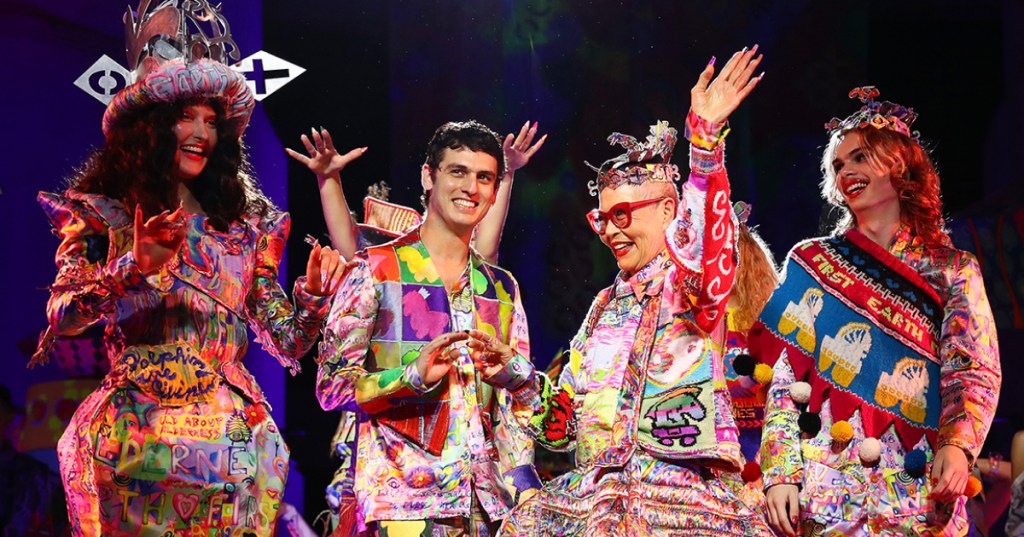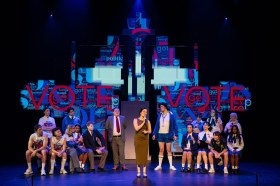The Powerhouse has collaborated with Iordanes Spyridon Gogos (ISG) for the 2022 Afterpay Australian Fashion Week (AAFW) in May. This joyful, kaleidoscopic carnival of a show brought together 56 collaborators (see a full list here), exploded the lines between fashion and art, and gave AAFW its biggest jolt of energy since – well, since 2021, when it gave ISG its runway debut.
Since then, ISG has been expanding its ambitions through a creative residency at the Powerhouse. For its 2022 runway show – the first in the Powerhouse’s 142-year history on the fashion week schedule – Jordan Gogos, the founder of the co-designed label, collaborated with architects, sculptors, florists, musicians, designers (including the legendary Jenny Kee) and the Powerhouse’s own workshop team. For inspiration, they turned to the Powerhouse itself, and embarked on a creative journey through the Powerhouse collections and archives.
‘Considering the gravity and scale of this project, I thought it would be really great for us as a creative team to understand where we are, who’s existed here prior to us, how the museum’s going forward,’ he said. ‘There are over 500,000 objects in the Powerhouse Collection – you almost can’t not be inspired by something. The collection here is wackadoodle-do, it’s completely out of bounds – they’ve got a chair from the first Big Brother! If you think “Who the hell has that? Where is that thing?” – the Powerhouse probably has it.’
Creative collisions
The creative team took certain objects from the Powerhouse Collection as starting point, then transformed them: Zaha Hadid shoes were cartooned by Apollo Michaelides, then printed on a dress; images of gems and ceramics were blown up, redrawn and layered into what Gogos calls a ‘royal collage’; fish and keys were taken as motifs. ‘There’s been a huge collision between the museum’s collections and archives and our process.’
For Powerhouse Chief Executive Lisa Havilah, it’s all part of an ambitious plan to embed the Powerhouse within a creative industries precinct as part of the renewal of Powerhouse Ultimo.
The Powerhouse currently provides subsidised workspace to 21 creative residents who work closely with the Powerhouse on programs, create work that connects to the Powerhouse collection and collaborate with us on major projects that are delivered by multidisciplinary creative teams.
‘It’s really a way of supporting the creative residents’ practice, but also extending the practice of the museum,’ said Havilah.
‘We as an industry need to look at how we create an ecology that sustains a designers and artists’ practice over the length of their career. This includes multiple layers of support including workspace, new ways to connect with audiences, creating international pathways and investing in ambitious creative practices.’

Fashion has been an important focus for the Powerhouse in Ultimo with the legendary label Romance was Born, and the ‘centre for blak excellence’ First Nations Fashion and Design also calling the Powerhouse home.
Given Gogos’ multi-faceted practice, why the focus on fashion? ‘I think that people respond to fashion because they can see themselves in it. Fashion can catapult ideas into the mainstream, almost like injecting them – it can send a shock wave. With a painting, you go and look at it. With fashion, you’re around it, you’re living in it, it travels; it can be in a box, it can be on a person, it can go on a runway. It changes the way people see it, how they engage with it, how it’s preserved.’
Fashion can catapult ideas into the mainstream, almost like injecting them – it can send a shockwave
Designer Jordan Gogos
Understanding the body
ISG’s logo is a fantastically coloured Trojan Horse. Gogos has said that ‘it symbolises the brand’s approach to breaking into the industry and ushering new ideas.’ One of his central concerns is diversity, which is why he asked Basjia Almaan to cast the runway show.
‘There’s such a fine line between “diversity” and having people who authentically connect with the brand.’ Gogos wanted people who understood and responded to the world his collaborators were creating. An important aspect of this was ‘adaptive making’. ‘We have an idea, we throw the piece onto the model at a very early stage, and we say, “What do you think? How do you feel?” Just making clothing isn’t relevant anymore. It’s about making to a body, and understanding [that person]. Maybe it’s understanding that they want a tattoo that they got 20 years ago covered up, and that is what will make them feel comfortable,’ Gogos explained.
Layer upon layer
Sustainability is another central tenet of ISG’s collaborative practice. Many of the garments are made from or layered with material from other constructions. Gogos used a giant felting machine (‘like a huge bed of needles’) to recycle fabric scraps from his designs and sewed with a machine that could work through up to ten layers of heavyweight material, so that garments could be cut out and have the scraps layered back into them in an almost endless process.
The Powerhouse’s workshop played a vital role in the project, turning the designers’ forms into 3D-modelled reality; providing expert, wide-ranging guidance on materials and techniques; and making dreams like Patrick Church’s hula-hoop dress and a lightbox hat (a tribute to gallery owner Sally Dan-Cuthbert) come true.
‘What we could achieve in the studio was one thing,’ said Gogos. ‘But what we could achieve in conjunction with the Powerhouse, and the team there, was astronomical, and I really don’t think it would be anywhere near the collection it is if we didn’t have their collaboration. We didn’t have to limit our ideas. I think people will definitely see the impact of resources being opened collaboratively to artists.’





